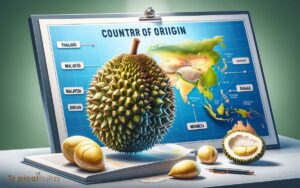Jackfruit Vs Durian Vs Breadfruit: The Ultimate Showdown!
Jackfruit, durian, and breadfruit are unique tropical fruits that have captured global interest due to their distinct characteristics.
Jackfruit is the largest tree-borne fruit, renowned for its meat-like texture, making it a popular meat substitute in vegetarian cuisine.
Durian, with its strong aroma and acquired taste, holds the title of ‘king of fruits’ and is a beloved delicacy in Southeast Asia. Breadfruit is a versatile staple in tropical areas, likened to a potato for its starchy quality when cooked.
Each of these fruits originates from different regions in Asia and the Pacific and offers a range of nutritional benefits and culinary uses, from sweet desserts to savory dishes.
Jackfruit, durian, and breadfruit are distinct in origin, appearance, taste, and use:
Discover the exotic flavors and textures of jackfruit, durian, and breadfruit, each with its unique culinary charm.
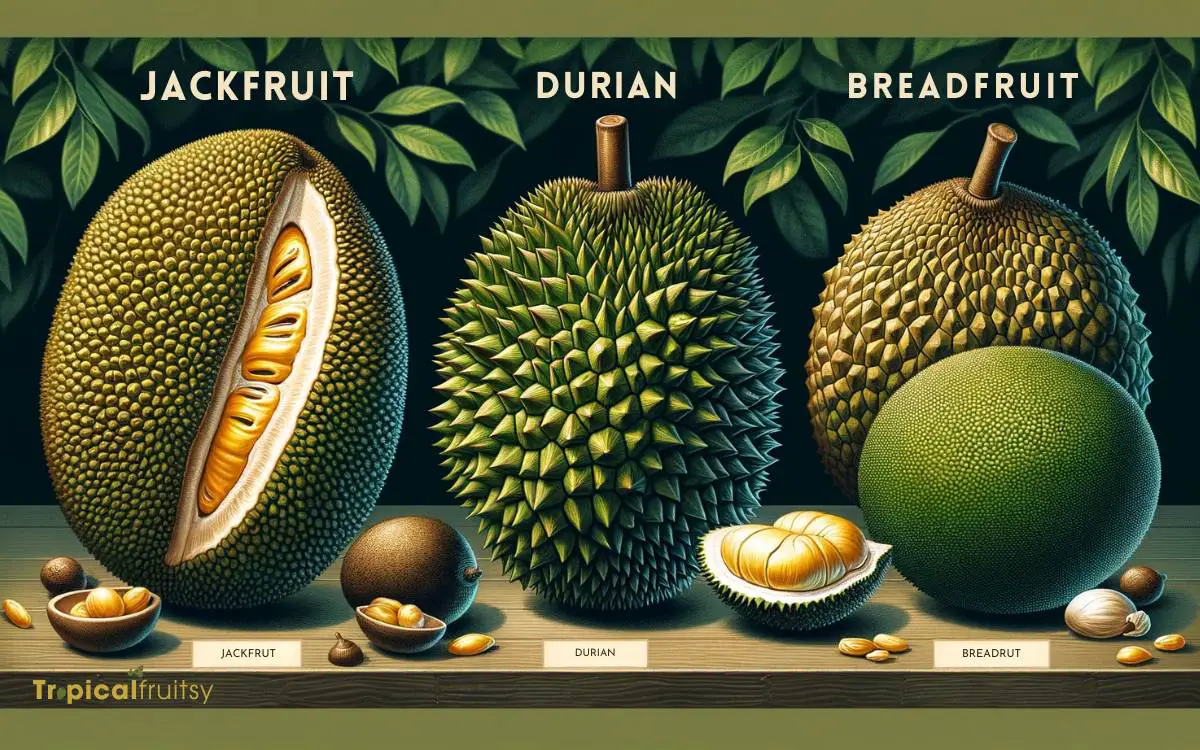
Key Takeaway
Nutritional & Culinary Comparison: Jackfruit, Durian, Breadfruit
| Fruit | Origin | Appearance | Taste and Texture | Nutritional Highlights | Culinary Uses |
|---|---|---|---|---|---|
| Jackfruit | South India | Large, bumpy, green exterior | Sweet, fibrous pods | High in fiber, vitamin C | Meat substitute, desserts, curries |
| Durian | Southeast Asia | Spiky shell, strong odor | Creamy, strong flavor | High in fat, calories | Desserts, eaten raw |
| Breadfruit | South Pacific | Green, scaly surface | Potato-like, starchy when cooked | Complex carbohydrates, vitamin C | Roasted, fried, boiled |
Origin and History
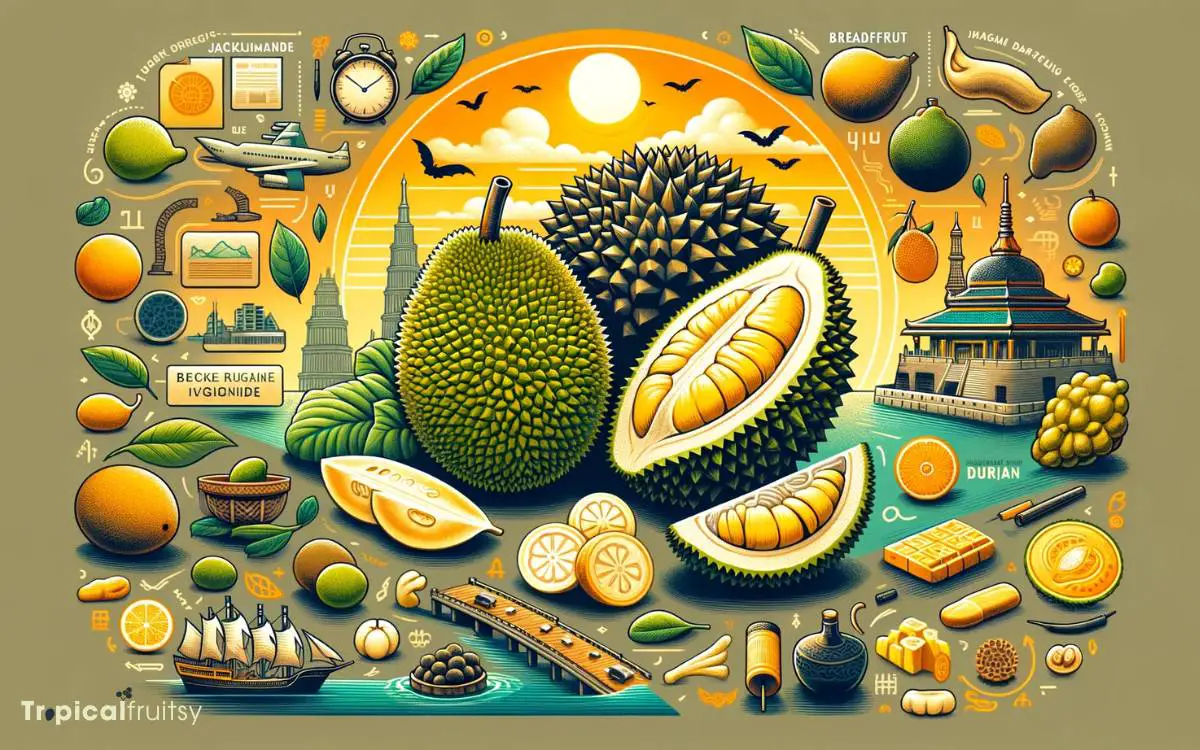
Tracing their origins through the annals of Southeast Asia and Oceania, jackfruit, durian, and breadfruit each have a storied history deeply rooted in the culinary and cultural practices of their respective regions.
The jackfruit (Artocarpus heterophyllus) is believed to have originated from the rainforests of the Western Ghats of India, and has since spread throughout tropical Asia.
The durian (Durio spp.), with its infamous aroma, is native to Borneo and Sumatra, and is widely revered in Southeast Asia as the ‘king of fruits’.
Meanwhile, the breadfruit (Artocarpus altilis) hails from the vast Pacific region, where it has been a staple food source and an integral part of the Polynesian navigators’ diet.
Each fruit plays a significant role in ecological, economic, and social spheres of their indigenous locales.
Physical Characteristics
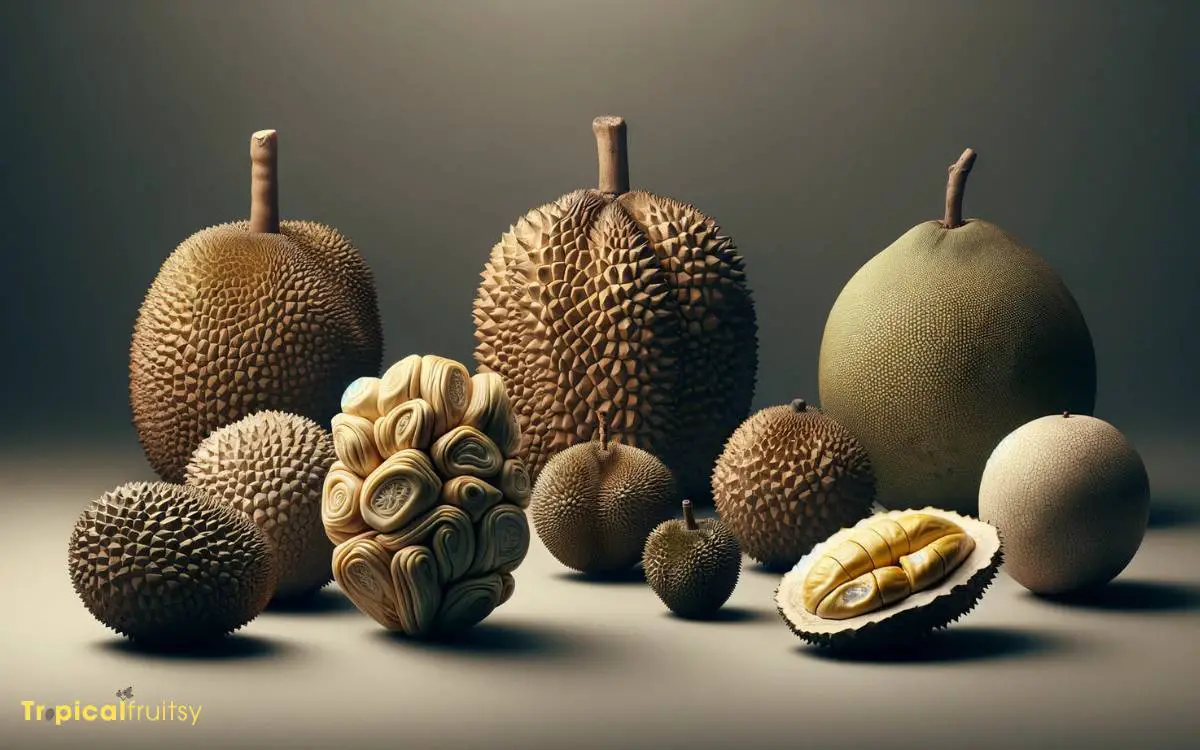
While each fruit boasts a unique historical significance, their physical characteristics are equally distinct, setting them apart in the realm of tropical produce.
- Jackfruit: The largest tree-borne fruit, jackfruit can weigh up to 55 kilograms and grow up to 90 centimeters in length. Its exterior is covered in a green or yellow spiky, hard skin, and houses numerous fleshy, edible bulbs.
- Durian: Known for its strong odor, the durian has a thorn-covered husk. It typically weighs 1 to 3 kilograms and contains a soft, creamy flesh that is segmented into large seeds.
- Breadfruit: This fruit is round to oval and can be as large as 30 centimeters in diameter. Its green skin features a pattern of reticulated, scaly bumps and encases a starchy, fibrous interior.
These morphological features reflect the adaptations of each species to their respective ecological niches and contribute to their identification and culinary uses.
Flavor Profiles Compared
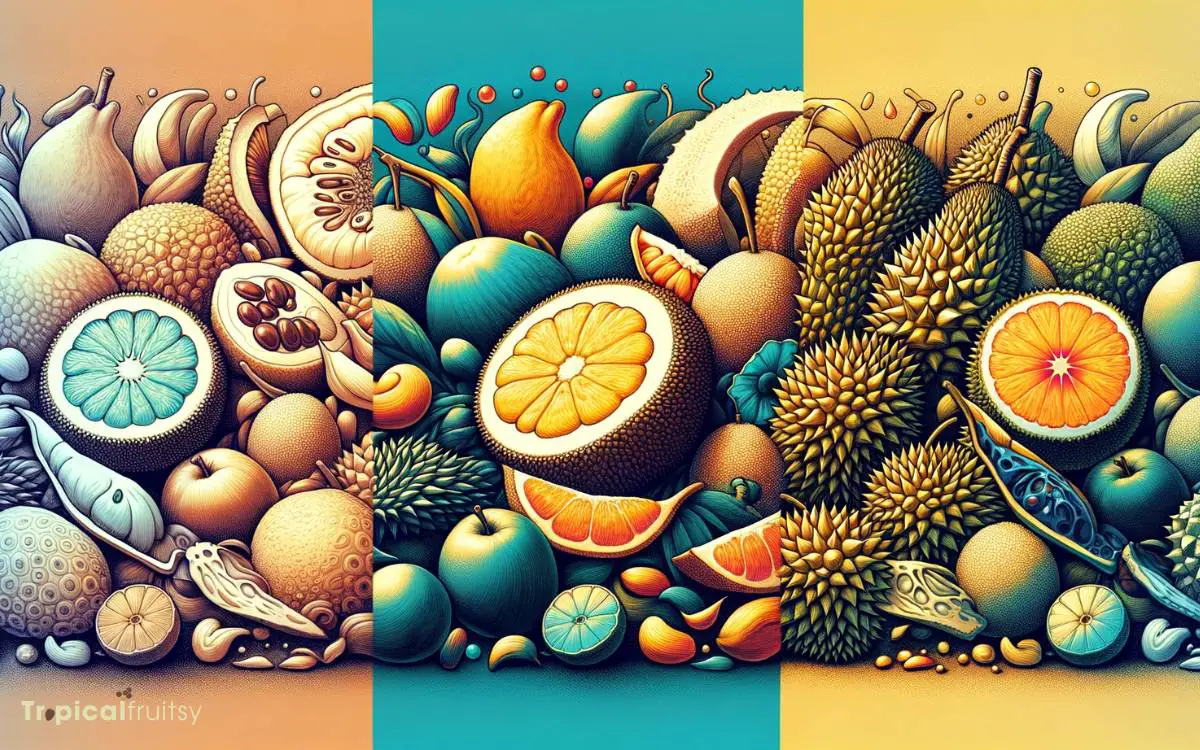
The flavor profiles of jackfruit, durian, and breadfruit exhibit distinct complexities and aromatic nuances that differentiate these tropical fruits.
Jackfruit is often described as having a sweet, fruity taste reminiscent of a combination of apple, pineapple, mango, and banana.
Durian’s flavor is more contentious, with a rich, custard-like texture accompanied by a potent, sulfurous aroma that can be off-putting to some.
In contrast, breadfruit has a milder taste and starchy texture that becomes sweeter and more flavorful when cooked, akin to freshly baked bread or roasted potatoes.
Taste Complexity
Jackfruit’s flavor profile is distinct and multifaceted, presenting a sweet, fruity taste reminiscent of a combination of apple, pineapple, mango, and banana.
Durian’s complex taste is often described as a rich blend of savory, sweet, and creamy, sometimes compared to almonds or cheese. Breadfruit’s taste is milder, resembling that of freshly baked bread or potatoes when cooked.
The taste complexity of these fruits can be characterized by:
- Jackfruit: A symphony of tropical flavors with a succulent sweetness and subtle tartness that varies with ripeness.
- Durian: An acquired taste with a unique interplay of custard-like texture and a flavor spectrum ranging from sweet to savory.
- Breadfruit: A starchy, somewhat bland palate that absorbs accompanying flavors well, making it versatile in various cuisines.
These distinct flavor profiles lead us to another sensory characteristic: aroma, where each fruit exhibits its own signature scent.
Aroma Differences
Our sense of smell is immediately engaged when we compare the aromas of jackfruit, durian, and breadfruit, each of which releases a distinctive scent that significantly influences its overall flavor profile.
Jackfruit is often described as having a sweet, fruity aroma reminiscent of a combination of banana, pineapple, and mango. This is due to the presence of esters, compounds that contribute to its pleasant fragrance.
Conversely, durian emits a pungent odor that polarizes individuals; it contains volatile sulfur compounds that can evoke smells similar to rotten onions or raw sewage to those who are sensitive to these chemical constituents.
Breadfruit is relatively mild in comparison, bearing a light, buttery smell when cooked, which can be attributed to its lower volatile compound content compared to durian.
Nutritional Benefits

Within the realm of tropical fruits, jackfruit, durian, and breadfruit are remarkable not only for their unique flavors but also for their diverse nutritional profiles.
Each fruit is a rich source of different vitamins, minerals, and dietary fibers that are essential for maintaining a balanced diet and supporting bodily functions.
- Jackfruit: High in vitamin C and dietary fiber, it also provides a modest amount of protein, potassium, and antioxidants.
- Durian: Known for its high caloric content, it is rich in vitamin C, thiamin, and manganese, along with essential fatty acids and tryptophan.
- Breadfruit: Low in fat, this fruit is an excellent source of complex carbohydrates, dietary fiber, and contains a variety of vitamins and minerals, particularly potassium and vitamin C.
These fruits offer a symphony of nutrients, contributing to a myriad of health benefits when incorporated into a diverse diet.
Culinary Uses
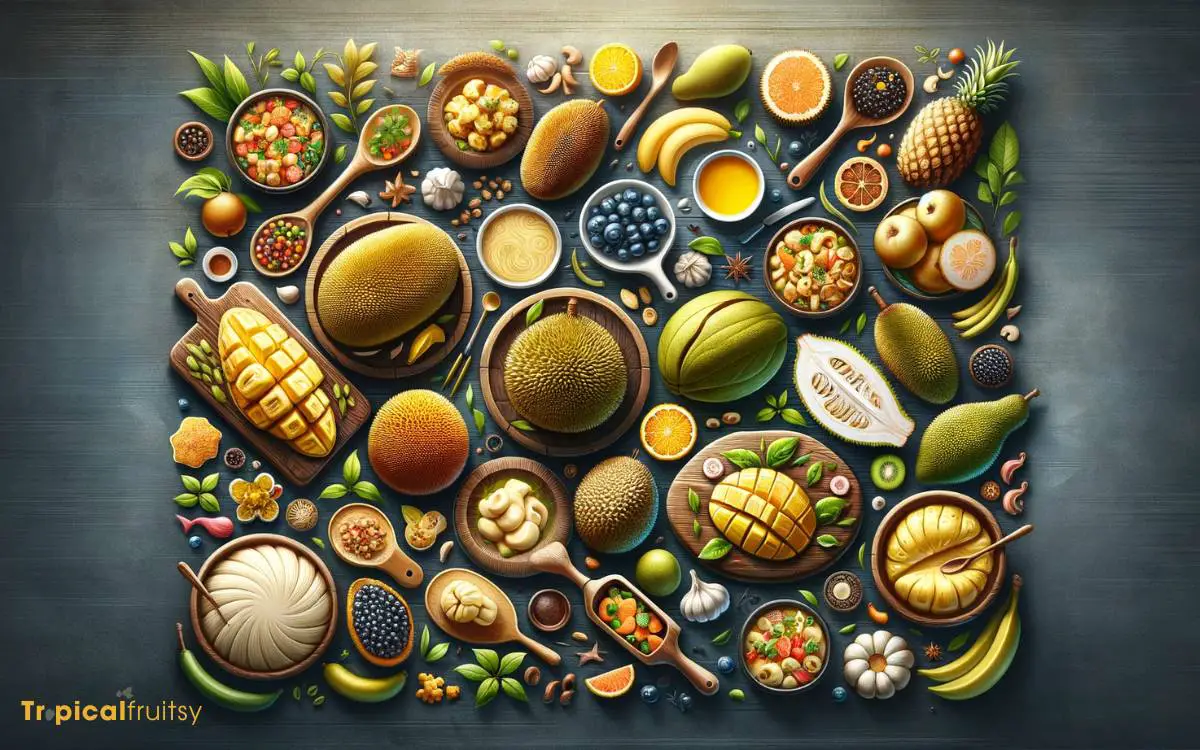
Transitioning from their nutritional profiles, the culinary applications of jackfruit, durian, and breadfruit reveal distinct cultural and gastronomic paradigms.
Recipe variations for these fruits range from savory entrees to sweet desserts, reflecting their versatile flavor profiles and textural properties.
Flavor pairing suggestions are guided by the unique compounds in each fruit, such as jackfruit’s isoamyl acetate or durian’s volatile sulfur compounds, which influence their compatibility with other ingredients.
Recipe Variations
The culinary applications of jackfruit, durian, and breadfruit vary widely, reflecting their distinct flavors and textures as well as their cultural significance in different cuisines.
These tropical fruits are each employed in a multitude of recipes, showcasing their versatility in both savory and sweet dishes.
- Jackfruit: Often used as a meat substitute due to its fibrous texture, jackfruit is a staple in vegan and vegetarian diets. It can be slow-cooked and shredded for use in tacos, curries, or as a filling for sandwiches and wraps.
- Durian: Renowned for its potent aroma, durian is primarily consumed fresh or incorporated into rich desserts, such as creamy custards, ice creams, and traditional Southeast Asian sweet treats.
- Breadfruit: Breadfruit’s starchy composition makes it ideal for frying, baking, or boiling. It is frequently transformed into chips, mashed as a potato alternative, or utilized in hearty stews and soups.
Flavor Pairing Suggestions
Several flavor pairings enhance the unique taste profiles of jackfruit, durian, and breadfruit when incorporated into a variety of culinary creations.
Jackfruit’s sweet and tropical notes harmonize with ingredients like coconut, lime, and chili, making it suitable for both savory and sweet dishes.
Its fibrous texture also allows it to absorb robust flavors such as smoked paprika or teriyaki when used as a meat substitute.
Durian, with its complex flavor reminiscent of custard, almonds, and garlic, pairs well with sticky rice and is often complemented by the mellow sweetness of coconut milk.
Breadfruit’s starchy, potato-like consistency becomes a canvas for aromatic spices such as cinnamon, nutmeg, and allspice in sweet applications, or curry and turmeric in savory dishes.
Exploring these pairings not only tantalizes the palate but also connects us to the cultural significance of these fruits.
Cultural Significance

While jackfruit, durian, and breadfruit each hold unique places in culinary traditions, their cultural significance extends beyond taste to symbolize heritage, prosperity, and community in various parts of Asia and the Pacific Islands.
The prominence of these fruits is deeply rooted in the socio-economic fabric of these regions where they are not merely consumed but celebrated through festivals, rituals, and folklore.
- Jackfruit: Often regarded as the ‘king of fruits’ in South and Southeast Asia, it represents abundance and is associated with auspicious events.
- Durian: Despite its polarizing aroma, durian is celebrated in Southeast Asia with festivals that highlight its economic and social value.
- Breadfruit: In the Pacific Islands, breadfruit is a staple food and a symbol of sustenance and resilience, often linked to traditional agroforestry practices.
These fruits carry with them a narrative of cultural identity and traditional knowledge, underscoring their importance beyond the culinary sphere.
Purchasing and Storage Tips

Beyond their cultural resonance, jackfruit, durian, and breadfruit require specific considerations for purchasing and storage to maintain their quality and flavor.
When selecting these fruits, one must assess maturity and integrity. Jackfruit should yield slightly under pressure, indicating ripeness, while durians should have a firm stem and a strong aroma, a sign of maturity.
Breadfruit’s readiness is signaled by its soft texture and sweet fragrance.
For storage, temperature regulation is imperative. Below is a table summarizing optimal conditions:
| Fruit | Storage Conditions |
|---|---|
| Jackfruit | Cool, well-ventilated area |
| Durian | Refrigerated; consume quickly |
| Breadfruit | Room temperature; ripen if needed |
To preserve quality, jackfruit and breadfruit are best consumed within a few days of ripening, while durians, due to their potent aroma, require isolation to prevent scent transfer to other foods.
Conclusion
Like divergent branches stemming from the same botanical tree, jackfruit, durian, and breadfruit each hold unique positions in the tapestry of tropical fruits.
They boast distinctive physical characteristics, complex flavor profiles, and varied nutritional benefits, while their culinary applications reflect the rich cultural heritage of the regions from which they originate.
Understanding their origins, properties, and uses can enhance appreciation and utilization, contributing to a more diverse and sustainable global food system.






